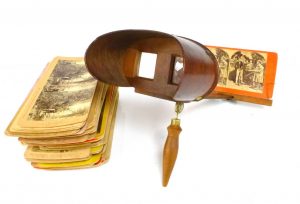 Stereography was an early form of three-dimensional photography. Two nearly identical images were placed side-by-side on cardboard. When viewed through a special viewer, the two images would merge into one with the illusion of three-dimensionality. Today this can also be achieved through animation, as seen in the video below.
Stereography was an early form of three-dimensional photography. Two nearly identical images were placed side-by-side on cardboard. When viewed through a special viewer, the two images would merge into one with the illusion of three-dimensionality. Today this can also be achieved through animation, as seen in the video below.
Stereographs became wildly popular during the second half of the nineteenth century. Affordable to everyone, they reached across class lines. By displaying views of far-away or inaccessible places, stereographs enabled viewers to learn about the world by imagining being there. Many nineteenth-century photographers who worked in the West produced large numbers of stereographs to support themselves, including Timothy O’Sullivan, Carleton Watkins, and Eadweard Muybridge.
Watch the accompanying video for a virtual stereograph viewer.
https://vimeo.com/202255055